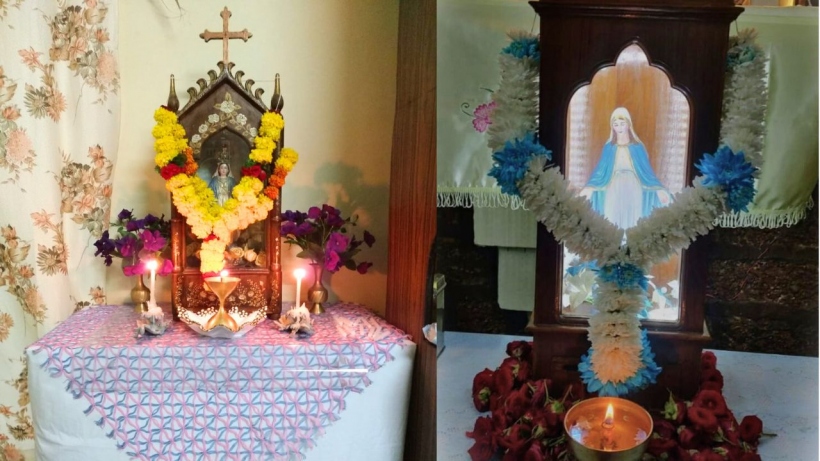
Frazer Andrade
‘Saibinn’ is a practice intended with a purpose of bringing parishioners together. On this day people from the whole ward come together and pray with the family in which the statue is being held. The word ‘saibinn’ is the feminine version of ‘saib’ which has been derived from Arabic (sāhib) meaning master.
In Goa, during the month of September, there commences a beautiful custom where one will notice the Catholic community in villages, gathering at an individual’s residence, at dusk where all those gathered, welcome an image of Nossa Senhora dos Milagres (Our Lady of Miracles). One may notice gold or silver jewelry adoring the statue of Our Lady. This jewelry is that, offered to Mary in thanksgiving, by the faithful on fulfillment of a particular vow. Here they would say a short prayer followed by three hymns seeking blessings of the Virgin Mary. The whole prayer service would take no longer than 20 minutes, after which biscuits and boiled Chickpeas with coconut was served. While the tradition of ‘Saibinn’, involving a house-to-house visitation of Mary, may have changed a bit over the years, the fervor surrounding it continues to be strong. On September 08, after the feast of the Nativity of Mary, parishes and chapels send out statues of Mary to all their wards, where she makes her way around the neighborhood, from one house to another, in a candle-lit procession to a vast repertoire of Marian hymns, many of which were generally composed locally and unique to every village. The practice of ‘saibin’ though begins in September, generally continues until December with a break in December during Christmas and commences once again after Lent, somewhere around April or May. Traditionally every ward village had one statue of Mary, which circulated around. However, due to increase in the number of homes in every village, the number of Marian statues taken around has been increased to more than one. It is indeed unfortunate that the locally composed hymns mentioned earlier have been conveniently forgotten due to priority given to given hymns printed in the ‘Gaionacho Jhelo’, a Konkani hymnal. A member of the family which was being visited by Mary, proceeds to his/her neighbor’s residence accompanied by friends, neighbors and close family to receive the statue. A short exit prayer is said there, followed by a hymn after which candles are distributed. Once the procession reaches the host’s residence at the door step, a family member incenses the statue of Mary, replaces the old floral garland adorning the oratory containing the image of her (garland offered on the previous evening by the earlier family) with a new garland, and places her onto a beautifully decorated table either adjacent or under the family oratory/altar in the host’s house. A member of the house would then lead everyone gathered, into prayer. The old garland was burnt to ashes in accordance with age old traditions of doing away with any sacramental. At every house, fire crackers are lit to mark the start and end of the ‘saibinn’. However, if the family taking the statue of Mery was mourning for someone who had passed away less than a year ago, no fire crackers were lit.
As the visitors left the house, they kissed the image of Mary using their right hand followed by dipping their index figure into the oil contained in an oil lamp placed in front of the statue, marking the sign of the cross onto their foreheads with the oil on their fingertip (it was considered a bad omen if the oil lamp went off). ‘Once the visitors left, members of the family would ordinarily sleep for the night in the room housing the statue of the Virgin and recite at least three rosaries, before the statue left for the next house, on the following evening’, mentions Mr. Agnelo Andrade, from Margão. It is noteworthy that in a patriarchal society, here an important space was provided to women to lead everyone into prayer. As the image of the Virgin Mary visited house to house, it was ensured that the statue was moved in one direction and never reversed. Taking the statue of Mary in the reverse direction meant a call for something inauspicious. Noted church historian Fr. Nascimento Mascarenhas traced the origin of ‘Saibinn’ to the year 1952, when the statue of Nossa Senhora de Fátima was brought to Goa from Portugal. He mentioned that in that year, 150 makeshift altars were built and 150 masses were celebrated. It was only after this occasion that, private visits in the manner they happen today, began. Fr. Carmo Martins of Orlim, was of the opinion that this devotion to the Virgin Mary, has been inspired by the 1830, apparition of Our Lady to Saint Catherine Laboure in Paris and may also be symbolic to Mary’s visit to her cousin Elizabeth. Some places such as Sernabatim in Colva followed a unique practice of constructing one or two arches made of Coconut palm fronds, so as to welcome the image of Mary into one’s home.
This tradition of ‘saibinn’ has a hidden practical purpose of actually promoting harmony and forgiveness. The main idea has been to keep families united and establish healthy relationships in one’s neighborhood. Traditionally, children would go house to house inviting neighbors to their place to celebrate Mary’s visit into their home. However as of date the invite is announced on the previous day at the residence of one’s preceding neighbor. Good relations were fostered after prayers when the host family distributed the chickpeas (chonne) and other snacks. However now, it is not unusual for the host to parcel the snacks and hand them over to their visitors as they leave their house. It is very unfortunate that people try and compete with their neighbor in terms of the snacks being served, thus making this tradition sadly turn out to be a display of one’s affluence. For example, in South Goa, well-to-do hosts may serve everything from fried rice to stew. These snacks are many a times served in disposable plastics which are an additional burden to mother nature. Approaches to environmental conservation need to considered by people distributing snacks in plastic. In a couple of parishes, for instance parish priests have appealed to their parishioners to adopt eco-friendly habits thus doing away with plastic.
While ‘Saibinn’ visits are encouraged, the church does not encourage these as a social obligation, in the fear that people may neglect their other duties. Attending to one’s families, volunteering one’s services and taking up social causes are more important than spending excessive amounts of time in religious ceremonies. As social beings there is the need to care for the society and do good in the world. People cannot get completely alienated spending hours in devotion. Of late it has been observed that traditional 20-minute services have been now prolonged to an hour or more thus bringing down the interests of youth, children and young adults in attending these gatherings, once intended to be held with a beautiful purpose. It is a sad truth that the increase in time duration of ‘Saibinn’ from about 20 minutes to over an hour will be one of the reasons contributing towards killing this beautiful tradition in the years to come.
